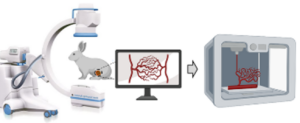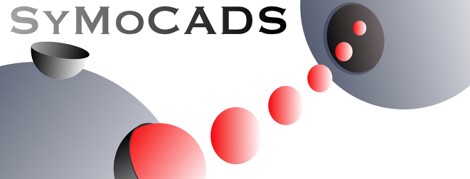Project P6
P6: Development of Tumor Models for MC based on Additive Manufacturing Approaches

Motivation and state of the art:
Magnetic steering of SPIONs via an external magnetic field with the objective of accumulating them in specified vasculature regions can be conveniently characterized under the MC paradigm1,2. As the behavior of circulating particles varies depending on the nanoparticle characteristics, magnetic field strength, and flow dynamics, a proper ex vivo model is required in order to estimate the magnetic capture of SPIONs in physiological-like settings. Yet, the state of the art for mimicking tumor (micro-)environments outside the human body are two-dimensional (2D) and murine tumor models, which are routinely used3. Although these conventional approaches are employed in preclinical studies4-6, they are expensive and difficult to adopt for routine drug screening. On the other hand, 2D in vitro models are simple to realize, but they do not adequately represent natural tumors, because they do not capture the important 3D multi-cellular heterogeneous components of the tumor environment7,2. In recent years, advances in 3D organoid culture technology have led to the development of novel physiological systems that model the original tissues more precisely than traditional culture methods3,4. However, existing systems cannot reliably reflect the fluidic processes of a 3D tumor with a diameter of several cm because they are focused on the extracellular matrix only, and/or are on a too small scale5. Therefore, the development of a physical model (mock-up) of the vascular and tissues structures of tumors and the surrounding blood vessels, which can serve as the basis for the design of efficient MC-based SPION steering systems, is highly desirable.
Objectives:
The aim of this project is the development of a fluidic tumor model, which allows the simplified modelling of complex fluidic processes outside and inside tumors. This includes the investigation of different additive manufacturing processes with regard to their usability for the production of tumor models with hierarchical complexity. Hereby, a basic set of typical geometries will be derived based on angiographic images of real tumors. Using simple geometries as a starting point, the complexity of the tumor models will be increased as the project progresses. Ultimately, the final model should not only represent different structures, including the complex capillary tissue, but also be made of transparent and flexible materials. These models are then to be used as sophisticated channel arrays for MC experiments. In particular, they will be exploited to validate the findings regarding the forces relevant for SPION steering in P4 and the MC channel models developed in P5. Furthermore, they will enable the experimental evaluation of the SPION steering systems investigated in P4 and P5 and the steering algorithms studied in P5.
References
1.Wicke, A. Ahmadzadeh, V. Jamali, H. Unterweger, C. Alexiou, and R. Schober, „Magnetic Nanoparticle-Based Molecular Communication in Microfluidic Environments,“ IEEE Trans. NanoBiosci., vol. 18, pp. 156-169, April 2019.
2.Schlechtweg, S. Meyer, H. Unterweger, M. Bartunik, D. Ahmed, W. Wicke, V. Jamali, C. Alexiou, G. Fischer, R. Weigel, R. Schober, and J. Kirchner, “Magnetic Steering of Superparamagnetic Nanoparticles in Duct Flow for Molecular Communication: A Feasibility Study” Body Area Networks: Smart IoT and Big Data for Intelligent Health Management, eds L. Mucchi, M. Hämäläinen, S. Jayousi, S. Morosi (Springer International Publishing, Cham), pp 161-174, Nov. 2019.
3.Sun, Z. Luo, J. Lee, H. Kim, K. Lee, P. Tebon, Y. Feng, M. Dokmeci, S. Sengupta, and A. Khademhosseini, “Organ-on-a-Chip for Cancer and Immune Organs Modeling,” Adv. Healthc. Mater., vol. 8, e1801363, 2019, doi:10.1002/adhm.201801363.
4.Kemper, et al., “Mechanistic and Pharmacodynamic Studies of DuoBody-CD3x5T4 in Preclinical Tumor Models,” Life Sci. Alliance, vol. 5, pp. 1-19, 2022, doi:10.26508/lsa.202201481.
5.Simeonova and E. Huillard, “In Vivo Models of Brain Tumors: Roles of Genetically Engineered Mouse Models in Understanding Tumor Biology and Use in Preclinical Studies,” Cell. Mol. Life Sci., vol. 71, pp. 4007-4026, 2014.
6.Fane and A. Weeraratna, “How the Ageing Microenvironment Influences Tumour Progression,” Nat. Rev. Cancer, vol. 20, pp. 89-106, 2020.
